Native Plant Conservation Program
The Oregon Department of Agriculture's Native Plant Conservation Program oversees the conservation and management of Oregon's listed plant species.
Assists federal, state, and local government agencies with the management of state protected plant populations found on their land, including consultations for impacts to listed species and development of management plans and conservation programs
Issues permits for scientific research and habitat restoration projects involving listed plants
Conducts research to enhance protected plant species recovery efforts
Periodically reviews listed species and candidate species for potential reclassification, removal, or addition to the State's list of threatened and endangered plants
The NPCP is involved in many conservation projects throughout the state, and assists land managers with listed plant species on their properties and works to support recovery goals for Oregon's listed species. Here are some of our conservation projects:
State endangered and threatened species list review
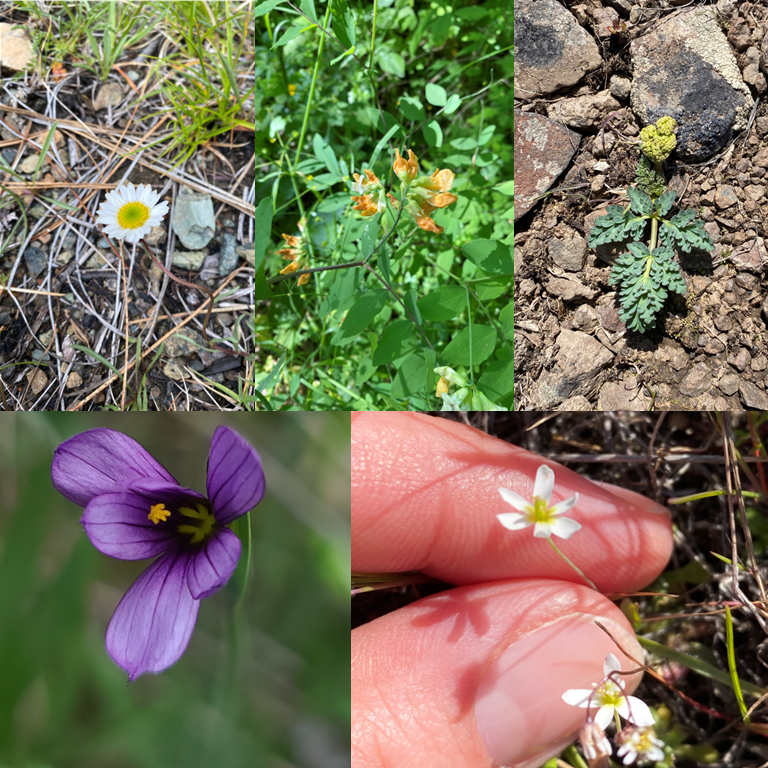
From top, clockwise: Erigeron stanselliae, Lathyrus holochlorus, Lomatium ochocense, Meconella oregana, and Sisyrinchium hitchcockii.
Over the 2021-2023 biennium, additional state funding supported a crucial review of species to be added to the State's list of threatened and endangered T&E) plants (maintained by the Native Plant Conservation Program as part of its regulatory authority), which was last updated in the mid-1990s. The work included processing substantial amounts of updated information, gathering outside recommendations and comments from experts and the general public, and conducting spot field studies to determine which plant species need a change in protective status.
Due to the number of unique species and habitats in Oregon, the list of species in need of review is extensive. Therefore, a subset of species will be reviewed on a rolling annual basis. In 2023, 13 species were reviewed and added to the State's T&E list following review by a Technical Advisory Committee and a public comment period.
Species review and the rule-making process for proposed changes to the State List of Threatened and Endangered Plant Species is one of the program's most important tasks over the coming years, as the state's Threatened and Endangered plant lists can impact on-the-ground activities of all state and local land-managing agencies.
Cooperative field project highlights
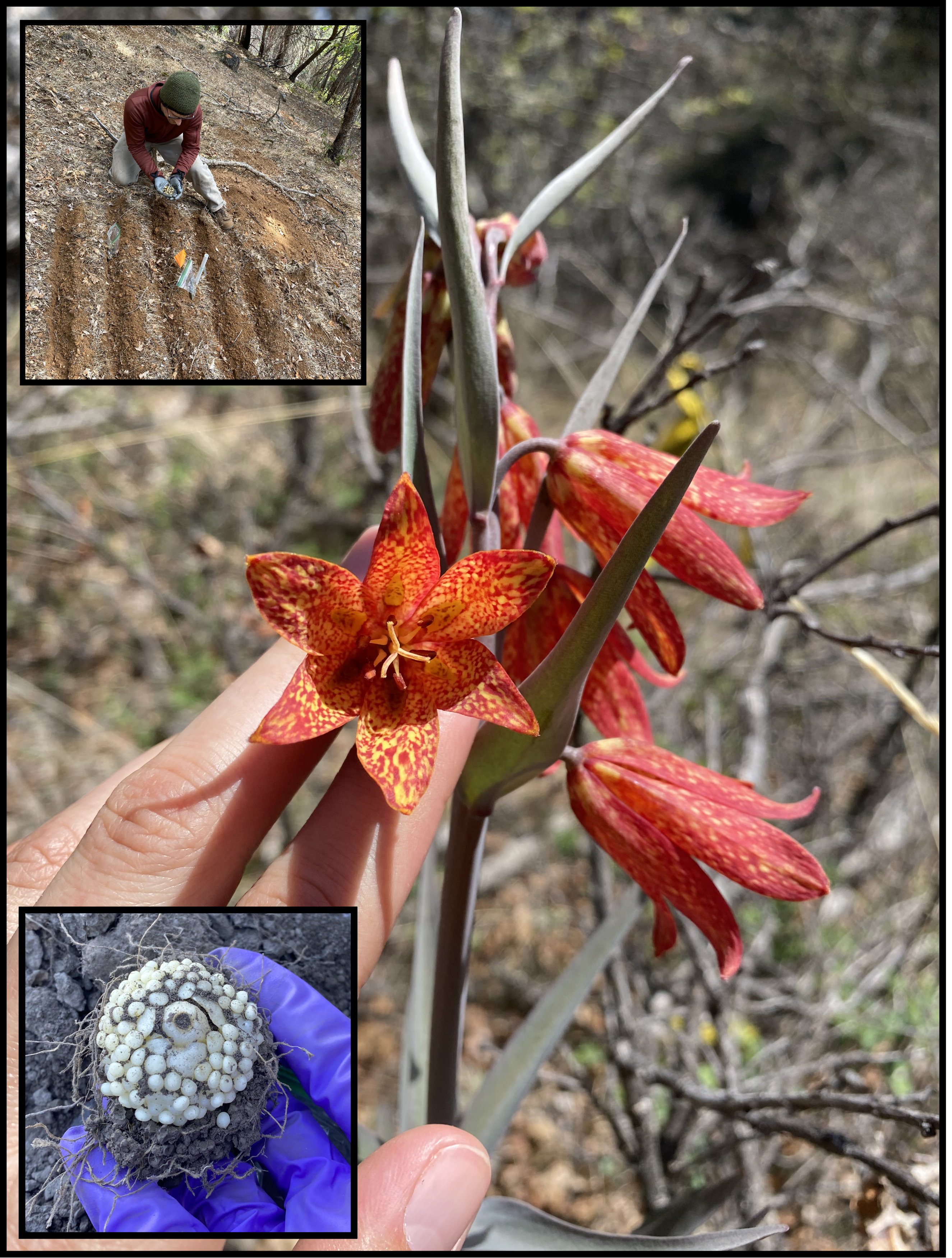
ODA continues to lead the recovery of the endangered Gentner's fritillary through the cultivation and collaborative transplanting (top inset) of bulbs and bulblets (bottom inset).
Gentner's Fritillary (Fritillaria gentneri) – Endangered, Showy Lily of Jackson and Josephine Counties
Partnerships with Medford District BLM and USFWS continued as the NPCP tracked and monitored Gentner's fritillary transplants that have been returned to the wild. Continued monitoring show the prospects for Gentner's fritillary are improving, in part thanks to the NPCP's transplanting efforts that support natural populations.
Cultivation of Gentner's fritillary transplants continued at our cultivation facilities at the OSU Greenhouses. Mature bulbs of this lily asexually produce many loosely attached grain-sized bulblets, which we can mature faster in greenhouse conditions. In the fall of 2021, ~45,000 of the NPCP's carefully tracked bulb and bulblet stock were transplanted back into the wild to increase population numbers across 10 sites. Additionally, to continue recovery efforts for this species ~1,250 bulblets were collected from 14 plants in the wild, potted, and will be cultivated over the coming years by our USFS partners at J. Herbert Stone Nursery for future outplanting. Conservation efforts will continue in 2023 monitoring Gentner's fritillary transplants.
Gentner's fritillary co-occurs with two other Fritillaria species, scarlet fritillary (F. recurva) and checker or chocolate lily (F. affinis). The non-flowering, vegetative individuals of these species are indistinguishable, consisting of a single leaf. To determine what percentage of the non-flowering fritillary leaves belong to the endangered F. gentneri, the NPCP partnered with OSU Botany Professor Aaron Liston to develop a DNA metabarcoding strategy. In the spring of 2022 and 2023, we collected leaf samples from flowering individuals of the three Fritillaria species and from unidentified non-flowering plants. Dr. Liston's lab has been processing the samples and identified the necessary components for identification at one of the sites, and is working on another site. This work could help identify many more Gentner's fritillary plants, helping the species reach recovery criteria for downlisting. We will continue this work in 2024 at additional fritillary locations.
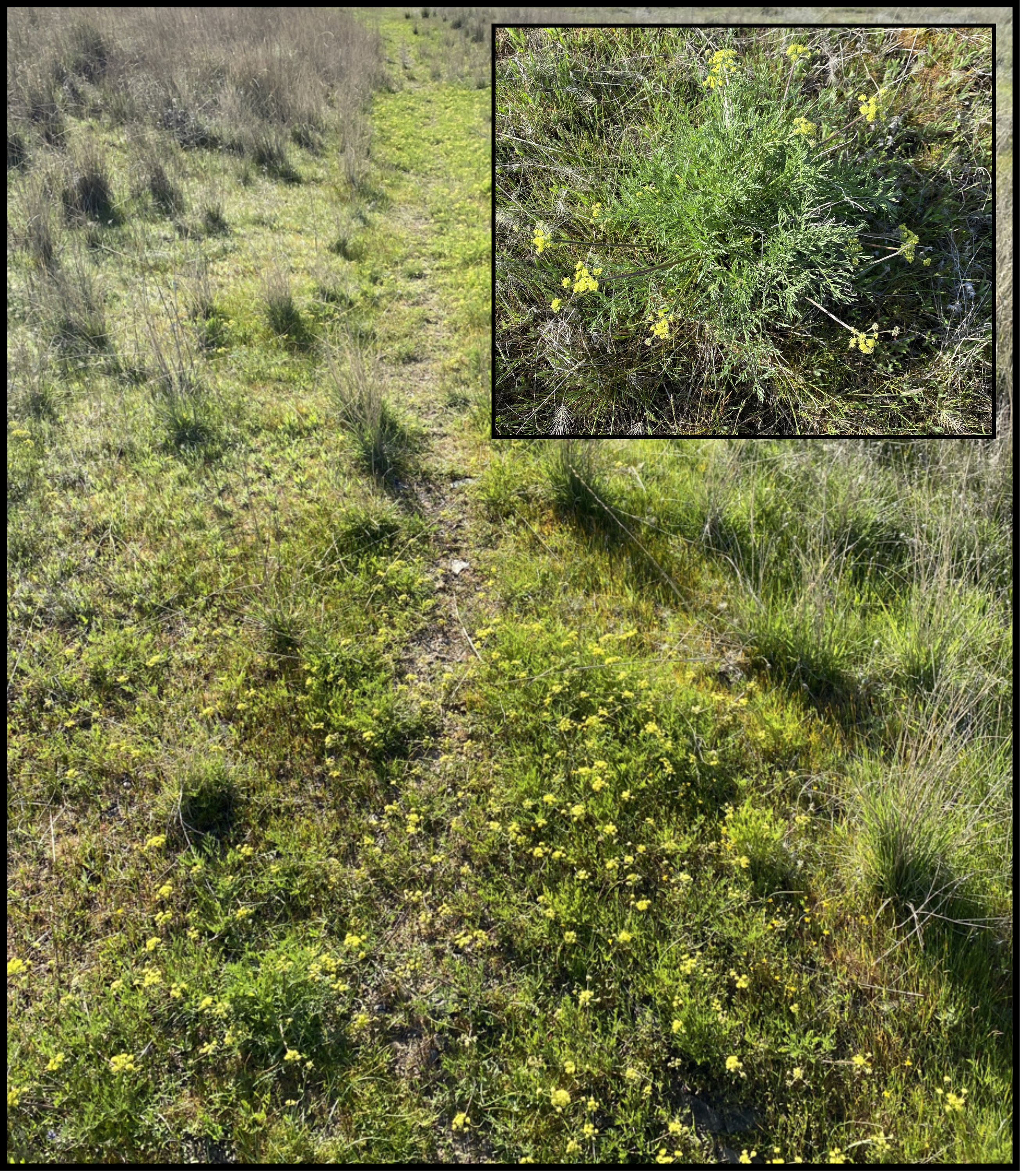
A surprising number of Cook's lomatium in bloom at a ODFW site in southern Oregon; this site shows strong promise for restoration and future seeding efforts.
Cook’s lomatium (Lomatium cookii) – Endangered, Vernal Pool Plant of Jackson and Josephine Counties
Cook's lomatium occurs in two main valleys, Rogue River Valley in the Medford area, and Illinois River Valley in the Cave Junction area. In 2021 and 2023, the NPCP partnered with USFWS to conduct a status evaluation of Cook's lomatium at sites across its range; this work included documenting number of plants, spatial distribution of the population, and information on the severity and distribution of threats (e.g., invasive weeds, altered hydrology, habitat loss, anthropogenic activities) at ~30 sites. Additionally, seed was collected from multiple sites to protect the genetic diversity of these populations, and for use in future recovery actions.
Our status evaluation report for Cook’s lomatium not only covers the results of our spring survey work but provides a comprehensive view of the species, collating survey data from many other agencies, including USFWS, BLM, ODOT, TNC, SOLC, the Institute for Applied Ecology, and ORBIC. The report presents recommendations for future action to recover Cook’s lomatium, including reinitiating a Recovery Team for the species, herbicide and prescribed fire trials, additional survey of populations, and development of a seed-increase program, which has now begun at the J. Herbert Stone Nursery.
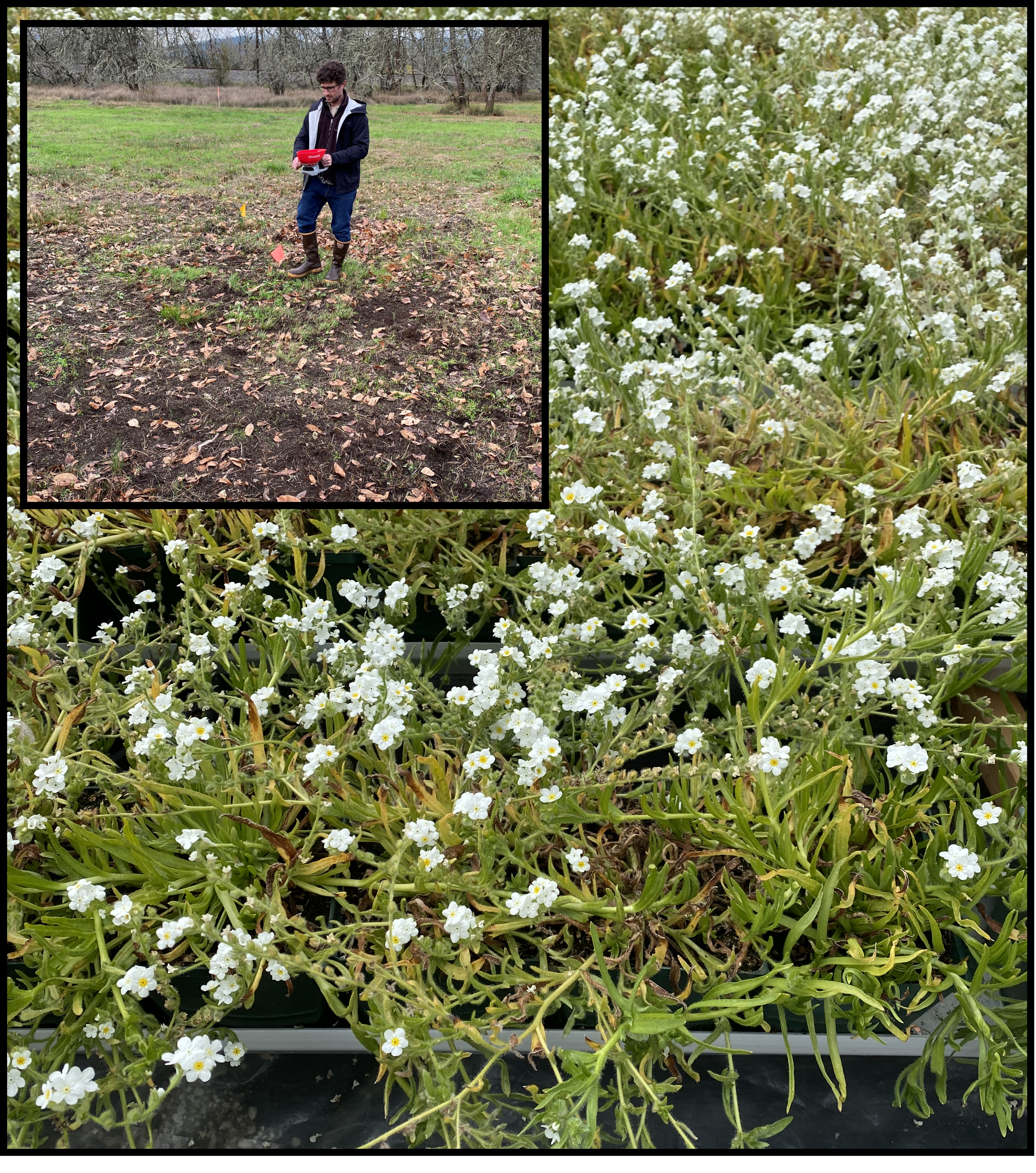
Rough popcornflower growing in pots in a unique bottom-watering system; seed collected from these plants were cleaned and dispersed at a protected site in Sutherlin, Oregon (inset).
Rough popcornflower (Plagiobothrys hirtus) – Endangered, Wetland Plant of Douglas County
In partnership with the USFWS Roseburg Field Office, rough popcornflower seed collected in 2020 was used to cultivate a seed crop in 2021 and 2022. NPCP staff cultivated over 1,100 rough popcornflower plants using a unique bottom-water system to mimic the plants' natural habitat. These plants survived the extreme heat in late June 2021, and that summer we harvested approximately 2 million seeds and were able to disperse seed into protected habitat that will bolster wild populations and meet administrative recovery goals. In 2022, we cultivated an additional 500 plants and spread that seed back into the wild later that fall. ODA will be monitoring the success of these seeding efforts in 2023.
The NPCP worked with Roseburg BLM partners to collect seed from rough popcornflower at BLM sites in 2021. We successfully cultivated plants that were transplanted back into the wild in the spring of 2022 and monitored their survival in 2022. We will be back out in 2023 checking on rough popcornflower at multiple sites across the species range.
Native Plant Conservation Program staff surveyed Howell's spectacular thelypody extensively at the largest population, counting every plant found; while many plants were small (<15 cm), a few were nearly 1 m in height, as pictured.
Howell's spectacular thelypody (Thelypodium howellii ssp. spectabilis) – State Endangered, Federally Threatened, mustard of Baker and Union Counties
In 2021, the NPCP partnered with the USFWS to survey Howell's spectacular thelypody populations in eastern Oregon, documenting number of plants, spatial distribution of the population, and information on the severity and distribution of threats at 10 locations.
- Our status evaluation report for T. howellii ssp. spectabilis not only covers the results of our summer survey work but provides a comprehensive view of the species, collating survey data from USFWS, ODOT, and ORBIC. This species has seen substantial declines in most populations, and the report presents recommendations for future action to recover Howell's spectacular thelypdody, including: stakeholder engagement, landowner outreach, increased monitoring over the next few years, and development of a seed-increase program.
- NPCP collected wild seed in 2022 to start a seed increase program at our OSU greenhouse facility. The rosettes look very healthy, and will produce seed in 2024. The NPCP will be back surveying T. howellii ssp. spectabilis and collecting additional seed in 2023.
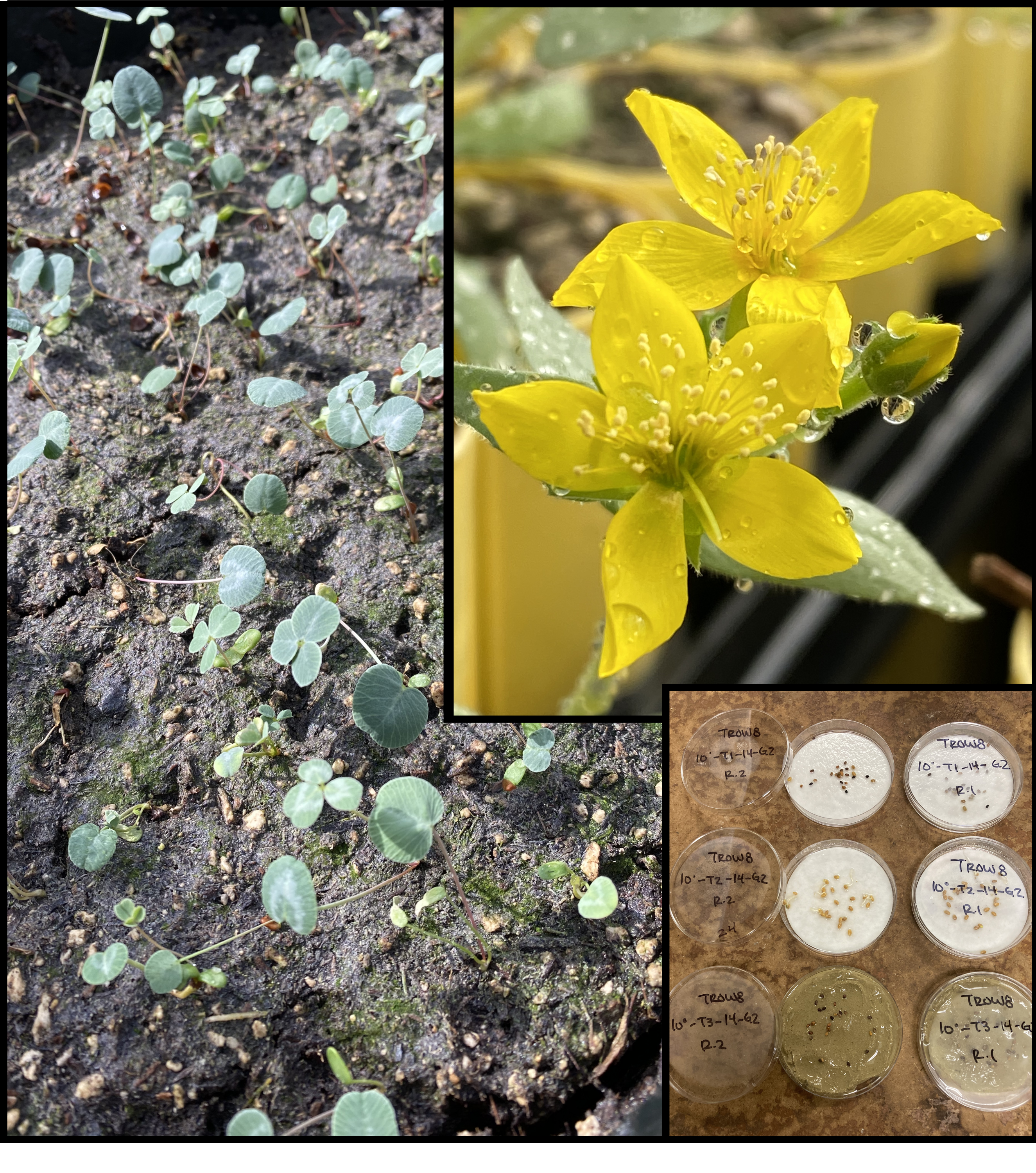
Owyhee clover (left) and flowering soft blazingstar (top right) in cultivation at OSU greenhouse facilities; the Native Plant Conservation Program worked with the OSU Seed Lab for the germination trial (bottom right) of seeds from both species.
Soft blazingstar (Mentzelia mollis) and Owyhee clover (Trifolium owyheense) – State Endangered, Federally Sensitive, edaphic endemics of Malheur County
Soft blazingstar and Owyhee clover only grow in unique ashy soils in the Succor Creek area of eastern Oregon. The NPCP’s ongoing work with these species is aimed at preventing federal listing. In 2021, NPCP staff conducted a germination study for each of these species, testing germination under multiple treatment (e.g., scarification, on soil, etc.), chill temperature, chill time, and diurnal germination temperature combinations. Successfully germinated seeds were cultivated over the summer and fall. Seeds were collected from the soft blazingstar capsules, and the Owyhee clover will overwinter outside under a rain shelter constructed by NPCP staff at the OSU greenhouses.
We determined optimal germination conditions for each species and have begun mass germination for future recovery efforts.